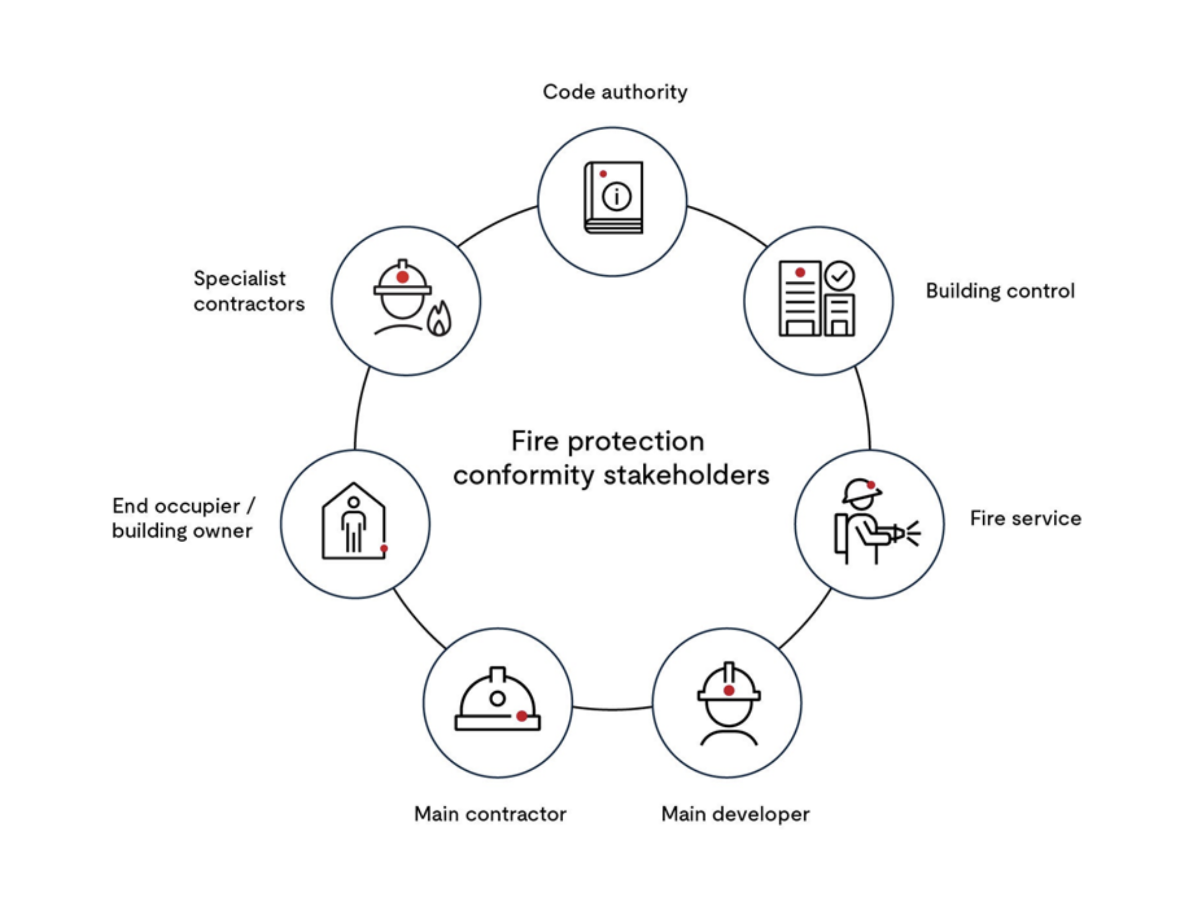
By Simon Ince, Project Manager, Codes and Regulatory Services, UL Solutions
The compliance challenge
Passive fire protection plays a critical role in protecting people, buildings and infrastructure. One essential component of passive fire protection is containment for penetrations in fire resistance-rated construction utilizing firestop systems. For firestopping systems to perform as intended, they must be correctly installed and demonstrate compliance with applicable fire and life safety requirements. Typically, a design professional, contractor, code official or building owner must evaluate installed conditions and determine if they meet code requirements. Some projects may also require inspections by a qualified third party. Regardless of who is responsible, stakeholders need reliable evidence that the systems in place can perform in the event of a fire. For example, a firestopped pipe penetration through a fire-rated assembly required to provide 60 minutes of fire resistance must be supported by test data demonstrating that the system met the performance criterion during a standardized fire test.

Figure 1: Diagram of stakeholder interest in a conformity decision
Testing vs. real-world conditions
Laboratory testing provides this evidence. But, in practice, the actual installation may differ slightly from the tested design. These differences, sometimes small, sometimes significant, raise important questions about how to access performance when the installed configuration doesn’t exactly match a tested system.
For example:
- The aperture size, cable size or number of cables differ from tested designs.
- The annular space between the penetrating item and the surrounding floor or wall is reduced or expanded.
- Multiple services pass through a shared opening in an untested configuration.
- The penetration angle differed from what was tested or what is specified in the published firestop system; most are tested at a 90-degree angle.
- A substrate doesn’t match the one used in the original test; standard substrates are used in testing to represent common wall or floor constructions.
Discrepancies between the available evidence and the actual installation can lead to last-minute requests for approval on site. In such cases, approval should be based on a technical evaluation, such as an engineering judgment (EJ) or an urgent fire test. These approaches help provide confidence to the code authority that the variation will not compromise the product or system’s performance. The goal is to demonstrate that variations, such as those mentioned above, would achieve the same performance under test conditions as the originally tested configuration. This provides technical evidence of performance and code compliance with applicable standards and regulatory requirements.
However, urgent fire testing of specific variations is often not practical due to the lead times required by fire testing laboratories. Delaying construction to wait for a test result is typically not feasible, especially when timely resolution is needed on an active job site. If actual testing is not a viable option, it still may be necessary in some cases. Another alternative includes replacing the installation with one that has evidence of conformity, assuming a tested and approved assembly can be identified.
Addressing fire protection failures on site
During construction, passive fire protection may go unnoticed and, therefore, may never be identified by anyone. There are many examples of fire protection noncompliance issues discovered after the building is occupied. In the worst cases, discovery occurs after a fire event.
Sometimes, a problem is identified before certificate of occupancy issuance but is not corrected in the hope that the deficiency goes unnoticed and doesn’t cause a failure in the future.
Ideally, such issues are discovered early, and additional documentation is requested to demonstrate code compliance. In these cases, a manufacturer or independent special inspector can seek an EJ for the proposed system. When EJs are required, they are most often provided by a product/system manufacturer that is knowledgeable about the products and competent in passive fire protection testing and design required for their materials.
The role of EJs
EJs serve a vital function in modern construction, especially when field conditions deviate from tested configurations. Stakeholders often prefer primary test evidence based on recognized fire tests on the specific assemblies being installed. However, testing every possible variation is impractical, if not impossible, due to the vast number of potential installation scenarios. Manufacturers typically test the most common configurations and rely on EJs for those that fall outside the tested scope. Still, questions often arise about the impartiality, technical rigor and oversight of these documents when they are developed solely by manufacturers.
Concerns include:
- Inconsistent qualifications of individuals preparing the evaluations
- A lack of independent oversight of the assessment quality management process
- A lack of investigation into the assessment methodology used
- A lack of confirmation of peer review or the technical accuracy of the assessments
Given these concerns, stakeholders need greater transparency and oversight when accepting EJs as evidence of compliance.
Raising the bar: The Technical Evaluation Developer Program (TEDP)
To support consistency, quality and stakeholder confidence, UL Solutions has developed the Technical Evaluation Developer Program (TEDP). This third-party oversight program evaluates and audits manufacturers who produce EJs for firestop systems. The goal is to raise the technical standard for EJs and support confidence in their use as part of a robust code compliance strategy.
TEDP establishes quality benchmarks for:
- Competence and qualifications of technical assessors
- Documentation of decision-making processes
- Internal audit procedures and continuous improvement
- Use of accepted industry guidance when developing assessments
Manufacturers enrolled in the program are audited by UL Solutions and must demonstrate that their EJs are developed using reliable, technically sound processes.
Independent testing and oversight
UL Solutions selects a sample of EJs issued by participating manufacturers and conducts fire tests to validate the engineering rationale. These tests are used to assess whether real-world fire performance aligns with the technical assumptions used in the EJ.
Manufacturers must also commit to ethical practices. For example, if a variation becomes common across multiple projects, manufacturers are expected to test and certify that configuration, rather than repeatedly using an EJ as a workaround.
A program built on accountability
Manufacturers participating in TEDP receive a certificate of enrolment, and their contact information is published in UL Product iQ® under product category WYGB (register to view). This publicly available database allows stakeholders to confirm program participation and verify whether a manufacturer’s EJs were developed under TEDP oversight.
UL Solutions conducts regular audits, including performance-based testing, to help confirm that program participants are meeting quality requirements. If nonconformances are identified, UL Solutions may increase surveillance or withdraw program recognition.
Supporting confidence in the field
For code officials, contractors, engineers and building owners, TEDP helps reduce uncertainty when evaluating nonstandard passive fire protection installations. When a manufacturer’s EJ is developed under this program, stakeholders can reference third-party oversight to support their acceptance decision.
To help identify companies committed to technical excellence, UL Solutions recently introduced a promotional TEDP badge for manufacturers meeting program requirements. This badge helps stakeholders quickly identify program participants committed to high-quality firestop assessments.

For more details of the scheme requirements, visit our Technical Evaluation Developer Program page or contact ULRegulatoryServices@UL.com.

